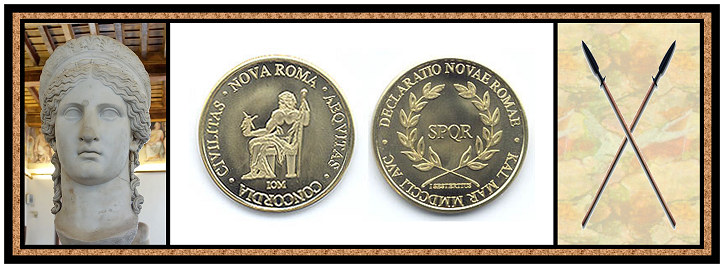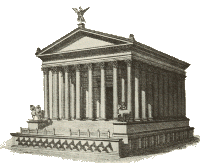Cultus Iuno Monetae
(Created page with "__NOTOC__ __NOEDITSECTION__ {{Virtualtemple | n=Aedes Iuno Monetae | i= aedem vovit St. Cornelia C. Aemilio cos. | d=pro populo Novo Romano | image=iunomoneta.png | linkslist= *...") |
m |
||
| Line 8: | Line 8: | ||
* [[Aedes Iuno Monetae]] | * [[Aedes Iuno Monetae]] | ||
* [[Cultus Iuno Monetae]] | * [[Cultus Iuno Monetae]] | ||
| − | * [[Ritus Iuno Monetae]]}} | + | * [[Ritus Iuno Monetae]] |
| + | * [[Aedes Iuno Monetae (Nova Roma)]]}} | ||
<!-- x x x x x x x DO NOT EDIT ABOVE THIS LINE x x x x x x x x x --> | <!-- x x x x x x x DO NOT EDIT ABOVE THIS LINE x x x x x x x x x --> | ||
Latest revision as of 09:34, 4 January 2014
Aedes Iuno Monetae
aedem vovit St. Cornelia C. Aemilio cos.
pro populo Novo Romano

|
Links
|
About the goddess, Iuno Moneta
Juno Moneta is the Roman Goddess of Good Counsel, whose name means "Advisor" or "Warner", said to give good advice to the people in general and those about to be married in particular. She had a large and famous temple on the Arx, a height on the Capitoline Hill in Rome, which was a site that had been sacred to Her from early times. Her epithet Moneta has been given various explanations, and it seems even the ancients weren't entirely sure where it came from. "Moneta" is usually assumed to derive from the Latin word for "warn", monere. One story goes that geese were sacred to Juno, and as such were kept at Her temple or cult center on the Capitoline. In the year 390 BCE, the Gauls surprised Rome with an attack on the Capitol, but the geese of Juno started a honking ruckus (as geese are wont to do) and the citizens were alerted and thus able to drive off the Gauls. In gratitude for the noble efforts of Her geese, Juno was honored with the name Moneta.
Another story goes that during an earthquake a disembodied voice was heard coming from Juno's Capitoline temple, advising or telling the people to sacrifice a pregnant sow. Presumably this was to placate the Earth Mother who caused the quake: for the sacrifice of a pregnant sow is almost exclusively given to Earth-Goddesses such as the Greek Demeter, because the sow is strongly associated with fertility and motherhood due to the high number of piglets in the average litter.
Yet another story says that during the war with the Tarentines, a group of Greeks from the city of Tarentum in Magna Graecia in the south of Italy, the Romans were in desperate need of money to fund their end of the war. They prayed to Juno, the protectress of the people, and were given the reply that so long as they fought in a just manner, they would not lack for money. They did, and the money flowed to them: when the war was over, they gave Juno the name Moneta in gratitude, either for the good advice or for the money itself that was given.
All that, however, may just be later attempts at explaning Her name: some scholars point to the true origins of "Moneta" in the Latin mons, "hill" or "mountain", used of the Capitoline Hill of Rome, with which Juno Moneta is deeply associated. Her main temple was located on the fortified height of the Arx (which means "citadel" or "stronghold") on the Capitoline. She must have had a temple or sacred place there from early times, and perhaps the location on the highest part of the Capitol had something to do with Juno's attribute as a Sky-Goddess Who hurled thunderbolts, or as protectress of the Roman people, as the height there would naturally provide a good vantage point. The later temple built there was vowed by the dictator Camillus Furius (whose father of the same name was responsible for building the temple to Juno Regina on the Aventine) in 345 BCE and was dedicated on the 1st of June, a.k.a. the Calends, a day doubly holy to Juno, since both the Calends and the month of June are sacred to Her. Alternately, the temple was dedicated on the 10th of October, while the June 1st date refers to the dedication date of an early altar.
In 273 BCE the Romans established a mint at Juno Moneta's temple, and for the next four hundred years or so all the silver coins of Rome were made there, up to the time of the Emperor Augustus in the 1st century CE. Juno Moneta then accordingly became associated with money and minting coins, and indeed both the English words "money" and "mint" trace back to Her epithet Moneta. Oddly enough for a temple of such importance and fame, no trace of it survives and no one is even sure now where it was located, though it is suspected to lie beneath the Church of Aracoeli. Quite unsurprisingly Juno Moneta is often depicted on coins, and is shown holding a pair of scales with which to measure out the money which lies in a pile at Her feet; She also frequently holds a cornucopia or horn of plenty as an emblem of abundance.
Two other theories as to the origin of Her name should be mentioned: some hold it more likely that "Moneta" comes from the mint, not the other way around; or that Her name comes from mons, "hill", meaning both the Capitoline and the Arx. If so, that would make Her primarily a Goddess of protection and of the high places, specifically the old citadel of the Arx. According to legend the Capitoline was the early settlement of the Sabine faction of early Rome (the Romans under Romulus having settled on the Palatine Hill); it is possible that Juno Moneta's origins were Sabine, for Her temple was built on the site of the former house of the early Sabine King Titus Tatius, said to have ruled jointly with Romulus. And like the Sabine Goddess Curitis, Who was considered an aspect of Juno, Juno Moneta seems to have had a military aspect—at least some weapons were apparently kept in Her temple, as one of the omens observed in the disturbed year of 196 BCE was of a pair of spears there which burst into flame. Now the Sabine people, who lived to the north and east of Rome, had a reputation as courageous and warlike, and their Gods were of a like character; they were eventually conquered by Rome and married into the Roman people, forming one of the major ethnic elements of Rome.
At any rate, Juno Moneta as Goddess of the Arx would accord well with Her aspect as one who warns, for from the height of the Arx one could command a view of the surrounding area and keep watch on approaching trouble. On a more abstract level, it also works with Her function as advisor, for from such a vantage point one is far-seeing, a very good quality in one giving advice. The spears kept in Her temple may indicate a protective or warrior aspect, especially of defense of the people, as does the association with Things Sabine; and/or they may refer to Her role as Sky-Goddess with the power to throw lightning-bolts, which are often symbolized by the spear. She was also believed to particularly protect money and monetary matters through Her association with the mint, an important aspect of protecting the well-being of the people.
Also called: Juno Moneta Regina (Juno Moneta the Queen); Pecunia ("Money"). She was identified with Mnemosyne, the Greek Goddess of Memory and mother of the Muses, the nine sisters of Inspiration; according to this She is then seen as the mother of the Camenae. This association of Juno Moneta and Mnemosyne is probably incorrect and caused by a misunderstanding of the root of the name Moneta.[1]
Notes
Master Index
Master Index
Master Index > Maintenance Categories > Pages to be deleted > English > Nova Roma > Religio Romana (Nova Roma) > Virtual temples of Nova Roma
Master Index > Maintenance Categories > Pages to be deleted > English > Nova Roma > Res publica (Nova Roma) > Magistracies (Nova Roma) > Curule Aediles
